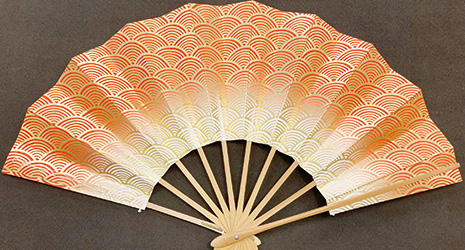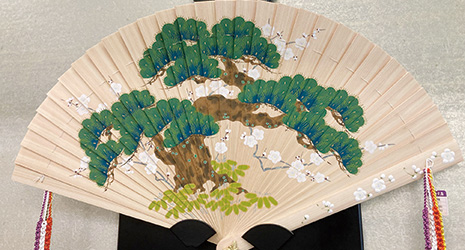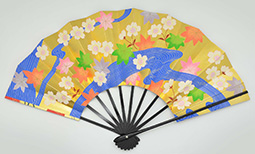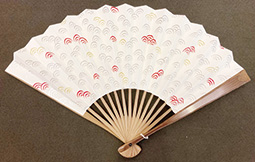December 2022
- English
- 日本語
Folding Fan Patterns

A sensu folding fan with a wave pattern 
A hiogi folding fan with a pine, bamboo and plum blossom design

A sensu folding fan with cherry blossom, maple leaf and flowing water motifs 
A sensu folding fan with a wave pattern

There is a nearly 1,200-year history of making sensu, or folding fans, in Japan. Traditionally, scenes from classical literature and various auspicious patterns are painted on the fans.

Sensu, or folding, portable fans, were thought to have been first created in the Heian period (late 8th to late 12th century) when dynastic culture blossomed in Japan. When a folding fan was opened, the face of the fan, which was decorated with various patterns, became visible. The motifs used are derived from auspicious patterns, or scenes of the imperial court from literary works that are now considered classical literature.
Originally called hiogi, these fans were made by weaving together thin, slender pieces of wood called mokkan and were primarily used by men. Later, the shape was refined, the fans were painted with designs, and their use spread to ladies in the court. Hiogi are thought to have been used less for cooling off than as objects of etiquette. Later, functional paper folding fans of the kind seen today appeared, with wooden ribs and paper pasted to one side, which users wave to cool off.
Painters added a variety of patterns to hiogi and the face of paper fans. What kinds of patterns were these? Takano Kyosuke works at Miyawaki Baisenan, a company which continues to produce these fans in Kyoto more than 200 years since its founding, and explains the following.
“Often, famous stories set at court were painted as themes for patterns on fans. Not surprisingly, Genji Monogatari (The Tale of Genji)* was popular. This story has 54 chapters, but it is thought that court aristocrats would have understood exactly what scene was painted just from looking at the paintings. I think that people were able to show off their refinement and good taste with the paintings on their fans.”

Later, these fans came to be used as props in performing arts such as noh and in the tea ceremony. And in the Edo period (early 17th to mid-late 19th century), those such as affluent merchants became prominent and began to favor the wearing of kimono with designs and patterns. At the same time, fans reached the hands of ordinary people and increased in variety.
Takano says that “it is speculated that at this time, the same designs used for kimono were also used for fans. Designs known as komon** began to be used, probably in large part because printing technology developed during this time, making it easy to design running patterns.”
Auspicious patterns in particular were favored as themes for komon. These motifs express happy omens for prosperity, longevity, and more. For example, hemp expresses health and growth, as the plant grows extremely quickly and is robust. A check pattern expresses prosperity for one’s descendants and business expansion as the same pattern continues without end. Wave patterns express unending happiness by depicting waves that blissfully spread out into the sea. There is a variety of types and meanings.

There are also patterns of scattered pine needles joined in pairs. Takano explains that “pine trees are symbols of long life, as they are evergreens and keep their green year round. Pine needles express good marital relations as even when falling from a pine tree, the two needles stay firmly connected and do not separate. Pine needles, with their multiple positive interpretations, have been a favored theme since ancient times. In addition to practical fans that are actually used, there are also some decorative fans that are used to decorate rooms. Pine and other auspicious patterns are also favored themes for decorative fans.”
The shape of the Japanese fan itself is auspicious and known as suehirogari. The shape expresses the development of the future from the kaname pivot, which secures the fan body’s framework at the base, to the opening out of the fan. Fans with auspicious patterns and double meanings became popular as items calling for good luck. The tradition of Japanese fans has been passed down for more than 1,000 years. No matter how much time passes, the auspicious patterns on the fans are filled with people’s unchanging prayers.
- * Genji Monogatari (The Tale of Genji) is a long story made up of 54 chapters written by Murasaki Shikibu in the early 11th century. It describes aristocratic society of the time. It is said to be one of the oldest long novels in the world.
- ** Refers to designing fans by repeating various patterns through a method of dyeing using stencils

